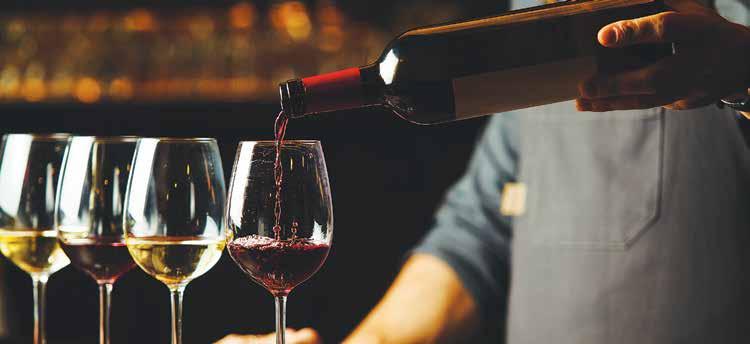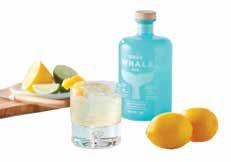
5 minute read
PLANET-FRIENDLY POURS
The Rise of Sustainable Wine and Spirits
by Sheila Julson
Iconic food and beverage magazines such as Bon Appetit and Food & Wine affirm that sustainable and socially responsible wines and spirits are becoming a major force in the market, yet consumers wanting to pour an Earth-conscious tipple need a sobering amount of research to sort through what’s truly eco-friendly.
The U.S. Food and Drug Administration does not require wine makers to list ingredients on labels or regulate the use of terms such as “natural” and “sustainably grown”.
“There are more than 70 additives that are allowed in wine that don’t have to be disclosed on the label,” explains Brad Kruse, who with his wife, Allie, owns Nonfiction Natural Wines, a Milwaukee-based specialty wine retailer. “The only real requirement relating to additives is the declaration of sulfites, which makes it trickier, because even wines with no added sulfites have to have the warning on the label because some naturally occur in the wine.”
Some wine labels tout that they’re made with organic grapes or grapes that are farmed sustainably. “But those may still have a host of other additives or lots of added sulfites,” says Kruse.
Certifications can act as a shortcut to locate eco-friendly wines. Demeter USA, for example, certifies vineyards that follow strict biodynamic rules for how the wine is farmed and processed, including limiting sulfites. But many small producers that operate naturally don’t bother obtaining certification.
Independent wine shops with knowledgeable employees can help consumers choose wisely. Kruse recommends looking for the name of the importer on the back label, saying, “If you learn a handful of importers that focus on naturally made wines, such as Louis/Dressner, Zev Rovine or Jenny & Francois, it can be a quick way to find a good option.”
Sustainability in the Vineyards
Rudy Marchesi, the former chairman of Demeter USA, practices biodynamic farming at his vineyard, Montinore Estate, in Forest Grove, Oregon. “We view our farm as one whole organism, below and above the ground,” he says.
Biodynamic farming, founded by philosopher Rudolf Steiner a century ago, requires using nutritionally rich compost teeming with microbiology of fungi and bacteria, as well as synchronizing specific farming practices with the seasons. These practices help the vineyards buffer droughts and weather swings, resulting in a consistent product that reflects the region. “Wine connoisseurs and collectors look for wines that have a sense of place and tell the story of where they’re from,” Marchesi says.
Distillers Move Toward Sustainable Practices
Alcohol is an agricultural product, so producing a sustainable spirit starts with the grain itself, says Herman C. Mihalich, founder and distiller of Mountain Laurel Spirits, in New Hope, Pennsylvania. “Rye is a much less resource-intensive grain to grow compared to crops like
corn,” he says. The recipe for the company’s signature Dad’s Hat Rye Whiskey calls for malted barley and rye, but no corn. “Rye doesn’t need much fertilizer and few, if any, pesticides. It’s easy to grow and it preserves soil because it’s a fall planting crop that helps prevent erosion,” he says.
Their grains are sourced from a nearby farmer, and they save water by capturing cooling water from the still’s condenser and storing it in a tank, then using it to clean tanks and make spent mash that can be used for livestock feed. The bottles are made locally by Stoelzle Glass, in Monaca, Pennsylvania.
When seeking sustainably produced spirits, customers have to do their due diligence, Mihalich says. “It requires a little digging and asking the right questions: What grains are you using and from where? How are you using water?”
When Extreme Chef host Marsh Mokhtari and his wife, Jan, founded Gray Whale Gin, they rotated proprietorship with two existing distilleries instead of using land and resources to build a new one. A vacation in Big Sur inspired the couple to “capture California in a glass” and make a product with ingredients found along the gray whale migratory route between the Baja Peninsula and Oregon. They hired a professional forager to collect juniper berries along the coast. “Juniper for most gin is sourced from Italy or Macedonia,” says Mokhtari. “We predominantly use juniper berries from California, which are light purple and larger, with a cedar component.” They also source mint and limes from sustainable farms in California.
Gray Whale Gin gives back through a partnership with the environmental nonprofits Oceana and 1% for the Planet. They recently joined with Oceana and former California governor Jerry Brown to support responsible swordfishing practices off the California coast.

Sheila Julson is a Milwaukee-based freelance writer and contributor to Natural Awakenings magazine.
WHALE HELLO THERE
2 oz sustainably produced gin ½ oz fresh lime juice ½ oz fresh lemon juice ½ oz agave syrup Fill a cocktail shaker with ice and pour in the gin, lime juice, lemon juice and agave. Shake vigorously and strain into a chilled martini glass, or over a glass filled with ice. Garnish with a lemon twist and serve immediately.
Recipe and photo courtesy of Gray Whale Gin.
Providing the World’s Best Herbs, Spices, and Teas for Your Kitchen.
DARK CHOCOLATE & SMOKED SEA SALT COOKIES
Think of these as your favorite chocolate chip cookies from childhood, all grown up. Dark chocolate chips accenting with aromatic coarse Smoked Sea Salt sets off the flavor of the chocolate and adds complexity.
INGREDIENTS Makes 30 cookies 1/2 Cup Unsalted Butter, at room temperature 1/2 Cup White Sugar 1/2 Cup Granulated Brown Sugar 1 Large Egg 1 Teaspoon Premium Vanilla Extract, Madagascar 1 1/4 Cups All-Purpose Flour 1/2 Teaspoon Baking Soda 1/4 Teaspoon Kosher Sea Salt Flakes 1 1/2 Cups Dark Chocolate, chopped 1 Tablespoon Smoked Sea Salt
DIRECTIONS
Preheat oven to 300°F. Line two baking sheets with parchment paper, and set aside. In the bowl of an electric stand mixer fitted with a paddle attachment, beat butter and sugars together until pale and fluffy. Add egg and vanilla extract and beat for 1 minute. Whisk together flour, baking soda and regular salt in medium bowl. Add dry mixture to wet mixture, and beat on low speed until just incorporated. Mix in dark chocolate pieces. Drop tablespoon-sized scoops of cookie dough onto prepared baking sheets, leaving about 2 inches of room between cookies. Sprinkle generously with Cherrywood Smoked Sea Salt. Bake cookies until just golden brown, about 15 minutes. Remove from oven and allow to cool on pan for 5 minutes. Transfer to a wire rack to cool completely.







